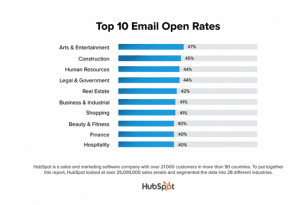4 Strategies for Getting Your Emails Opened and Answered

Does every prospect or client open every email you send? And what about actually taking the action you ask them to take in that email – be it reply to you or to click a link? No and no. You’re thinking “Duh! Stupid questions, Bill.” I know. Stay with me for a couple of minutes…
Do You Know the Open Rate for your Emails?
Have you ever tracked the open rate for your 1:1 emails? Did you know that some industries rank higher than others with regard to their open rate? For example the financial industry is in the top 10 for best sales email open rate. No surprise here, because it’s about MONEY!
HubSpot has a very cool tool where you can compare your open rate with others in your industry and even across industries if you like. Not sure what you’re open rate is? Just put in a number into their calculator and you’ll see how that number stacks up.
The open rate for general email newsletters is usually pretty low with the proliferation of email newsletters – typically in the 10-25% range. However, your open rate will grow in direct correlation with the quality of the relationship you have with the recipient of your email.

Getting a Better Email Open Rate – Simple, but Not Easy
So what does it take to get someone to open an email and then take further action? The formula is actually quite simple. It’s the darn execution that no one has fully figured out! In fact, if anyone promises you a certain open rate, don’t believe them, put on your running shoes and get moving. Even if they’ve actually reached those numbers for themselves or other clients, everyone’s situation is different. What I do to increase my results may end up doing the exact opposite for you. And vice versa.
Email has been accessible to the general public since the 70’s, but didn’t really hit widespread general use until the early 90’s. However, the principles behind sales and marketing with email have been around since… well… the Pony Express. Sales and marketing with email falls under the general category of Direct Response Marketing. “Do you mean Direct Mail? Junk Mail?” Yup. But never forget that one person’s junk is another person’s treasure. With a few exceptions, the principles of Direct Response Marketing are the same now as they’ve always been.
IMPORTANT: Whether you are sending one specific email to one specific person or more of a “bulk” mailing (like your electronic newsletter, for example), these principles hold true. Keep them in mind each time you craft an email to a prospect, client, or strategic partner.
Use These Principles of Direct Response Marketing to Increase Your Email Open Rate (and Get People to Take Action!)
Strategy #1 – You’re Making a Series of Small Sales
Just about every part of the sales and marketing process is one small sale that leads to the next. Your email subject line has one main job – to get the recipient to open the email. That’s pretty much it. No open, no reading, no further action. If your email is to a prospect who has been referred to you, make sure you use the referral source’s name at the beginning of the subject line; “Referred by Laura Smith” or “Bob Jones asked me to contact you.”
The opening sentence has one main job – to stimulate interest; to pull the reader in so they shut out the rest of their world for a few minutes and pay attention to you. And on it goes. When you know the job of each component of an email – or any other sales and marketing activity for that matter – it’s much easier to tweak, test, and produce results.
Strategy #2 – It All Starts with Being Relevant
Have you ever received an email from someone with a message that causes you to think, “This guy has no clue who I am or what I do. This is irrelevant to my life and my business. Why are you wasting my time?” And have you ever been interested in a product or service, set up an online demo or even an in-person meeting, only to have the person launch into their features and benefits pitch without really knowing much about you? Yes and yes! Irrelevance is the first killer of sales and marketing results. Your brain makes an almost instantaneous decision to move on.
I like to distinguish between two levels of relevance; macro and micro. Macro Relevance comes from your clarity and important decisions about your target market – your willingness to not make the classic mistake of trying to cast too big a net so as to water down your relevance. The best marketers have identified their one, two, or three key personas – the demographic and psychographic attributes of their best prospects and clients.
Look… you can have more than one market, but if you do, you better treat each one as differently as they truly are. Different personas should get different headlines and messages – so that they are as relevant as possible; so that they read your words and say to themselves, “This fits my world” or “This guy/gal gets me.”
The more targeted your market(s), the more you are able to write and speak with the words that make your messaging relevant to your audience.
Micro Relevance is what you do to get super narrow with your message, all the way down to one specific person. Your ability to create relevance comes from truly knowing and understanding your market; their problems, their dreams, their obstacles, and their goals. This “knowingness” comes from research.
For the last 25 years, I’ve been helping businesses, sales professionals, and other professionals acquire more, high-level clients through purposeful word of mouth, referrals, and introductions. So let’s use that as the context for an example of creating a Micro Relevant message.
Cold Research is what you learn about your prospect by looking at their LinkedIn profile, Facebook page, business website, or any other type of internet search. Cold research can often be very helpful, but incomplete.
Warm Research is what you learn from someone who knows your prospect – namely – your referral source. The more you learn about your prospect, the more relevant you are and, therefore, the more likely you are to catch their interest – at least for a little while. A great example of this – to help you make your message truly relevant – is to ask your referral source, “What’s going on in their life that’s really important to them right now? What’s foremost on their radar at the moment?”
Before you send any email to your prospects, clients, and strategic partners – be it a 1:1 message or group email – ask yourself the question, “Is the subject line and email message specifically relevant to the recipient? Will it grab and retain their attention?”
[arve url=”“]
Strategy #3 – It Continues with Being Compelling
Equal in importance to having Relevant Messaging is to have Compelling Messaging. Effective messaging must always have both elements. In my mind, Compelling equates with movement or action. A compelling message often addresses the emotional side of your messaging; it’s the motor that keeps your relevant message going.
You probably already know that when a prospect or client takes an action that you ask of them, it’s an emotional decision for them. Research has shown that “subjects with brain damage who could not feel emotions could not make decisions – even the most mundane decisions.”
Shall I cut to the chase? To the proverbial bottom line? If you are not getting an acceptable level of people opening or responding to your emails, then your messaging isn’t relevant enough, compelling enough, or both.
Please Don’t Do This!
I appreciate good marketing and good salesmanship when I see it. (Saleswomanship?) One of my many pet peeves is a clever email subject line that gets me to open the email and is then followed by a message that either doesn’t relate to the subject line or is irrelevant to me – therefore wasting my time.
Create congruence in your messaging. Create a flow. I’m not saying you can’t be counterintuitive, clever, or even somewhat controversial. Sometimes you have to do those things to grab someone’s attention. But a message that lacks congruence is simply irritating. Sure, you might increase your open rate, but that doesn’t mean they’ll take the next action you ask of them. And it might mean that by aggravating the recipient, you will reduce your effectiveness in the future.
Can you imitate ideas that you see others use, such as parts of a subject line that got you to open an email from an unknown source? Sure thing! But remember that you’re making a series of small sales – small steps toward the desired action – and you must remain relevant and compelling all along the way.
Strategy #4 – Tell Them What You Want Them to Do
You should never, ever assume that the reader of your emails knows what they should do next. If you want them to reply, click on a link, or take some other action – tell them to do it.
Marketing experts call this your “Call to Action” or CTA. Every piece of marketing or sales related correspondence have a CTA. “To see how you stack up against others in your industry, CLICK HERE” “Open the attached report to get the full agenda” “Hit reply if you want to reserve your spot.”
Personally, I think some marketing CTAs get a little too cute for my taste, but you should usually look for something a little different than the “For More Information, Click Here.” “More information” isn’t as compelling as “see where you stack up against others…”
PLEASE Leave a Comment or Ask a Question
I’m extremely interested in hearing from you – your reaction to this article; with what you agree and/or disagree. Do you have any strategies for increasing your email open rate? Let’s have a robust discussion, shall we?
UPCOMING EVENTS



